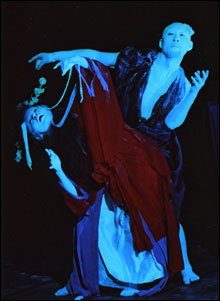
TO THE WHITE, TO THE SKY: Shattering in its unexpectedness. |
To American eyes, butoh dance is the ultimate in weirdness. Still, we don’t often see anything as beautiful, surprising, and even transcendent as this contemporary synthesis of folk art, high art, and metaphysics. The Japan Society of Boston brought us a taste of the real thing on November 8 with a single performance of GooSayTen’s To the White, to the Sky, at Zero Arrow Theatre in Harvard Square. Butoh dance has a look, a base line of physical dislocation, from which intimate essays and spectacular theater can develop. Covered in white powdery make-up and shrouded in shapeless garments, the dancers’ bodies and limbs curl inward, flex into rigidity. Bare feet drag along the ground, hands claw inarticulately at the air. Often the hands and feet are the only identifiable human features in the amorphous, anonymous shapes that tremble before us. Suddenly or imperceptibly, the outlines materialize into bizarre, suggestive images and dissolve again.
Butoh really begins with a Zen-influenced physical practice that demands great inner control, the emotions so stifled that they distort the body. It’s the opposite of Martha Graham’s modern dance, where movement resulted from a Dionysian release of inhibitions. You can’t “read” butoh like an expressive portrait. With eyes shut or turned inward, mouths that open ecstatically, unreasonably, the dancers’ faces are as private as masks. They move at a pace just this side of stasis, so that nothing seems to be happening at all, but these long spans of slow motion take on the epic significance of journeys, battles, sacrifice, birth and death, desire.
To the White, to the Sky begins in the dark. Your eyes adjust, with a little help from the lighting designer (Takahashi Masakazu), so you can make out two inert lumps. Straining to see something, you identify two people, one standing, one sitting or kneeling. They’re so still, you’re not sure they’re alive. As I stared, I began to hallucinate, or maybe I blinked. Did that standing figure twitch? Did its shoulder lift an inch?
When they start to move, the taller figure staggers from one foot to the other, stiff and unstable, threatening to topple over with every step. He holds his forearms extended, hands up as if asking an unanswerable question. The figure on the ground slowly rotates toward the audience, reaches out to the man, seems to be trying to crawl, and finally rises. Both figures seem to have their heads covered, and they walk stooped over, like very old people.
During the next hour or so, the man and the woman (Morita Itto and Takeuchi Mika) move in minute increments, self-contained and unaware of each other except for some extraordinary instants of contact. If they are having some kind of occluded relationship, its meaning changes as you look at it. It could be sexual — it probably is sexual. But it could also be religious, or political. Or primitive, pre-human, biological.